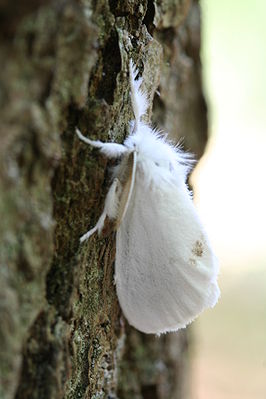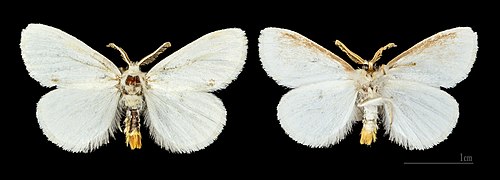Swan (butterfly)
| swan | ||||||||||||
|---|---|---|---|---|---|---|---|---|---|---|---|---|

Swan ( Sphrageidus similis ) |
||||||||||||
| Systematics | ||||||||||||
|
||||||||||||
| Scientific name | ||||||||||||
| Sphrageidus similis | ||||||||||||
| ( Fuessly , 1775) |
The Swan ( Sphrageidus similis ) is a butterfly ( moth ) from the subfamily of tussock moths (Lymantriinae) within the family of cutworms (Noctuidae).
features
The moths reach a forewing span of 30 to 36 millimeters. The females are significantly larger than the males. Above all, the abdomen looks a lot more powerful, because it contains the 200 eggs and the substances that are necessary for their production. The wing color is snow white with a dark spot on the upper side of the forewings. At the rear end of the abdomen there is a strikingly yellow tuft of hair that resembles that of the gold afer . Sometimes there are also other color variants. The swan is active at dusk and at night.
Similar species
habitat
You can find this butterfly species in open parklands, light deciduous forests, orchards and gardens all over Europe . The distribution area extends in the north from central Scandinavia to southern Finland .
Way of life
The caterpillars feed on hardwoods such as poplars , linden trees and oaks , but cherry , apple and plum trees are also in demand, so that in some cases considerable damage occurs in orchards.
Flight and caterpillar time
These animals fly from June to August. The caterpillars can be found from September to May. The females lay their eggs on the underside of leaves and cover them with the yellow hair of their abdomen. Immediately after hatching, the caterpillars start eating. After the second moult, they pupate and overwinter in cracks in wood or in fallen leaves. Against enemies, the caterpillars are colored in the warning colors black, white and red. In addition, they are covered over and over with caustic hair, so that an enemy will not attack them again if they have already had a bad experience.
Other name combinations
Euproctis similis (Fuesslin, 1775)
Phalaena similis (Fuesslin, 1775 | original combination)
swell
literature
- Günter Ebert: The butterflies of Baden-Württemberg. Volume 4: Moths II (Bombycidae, Endromidae, Lemoniidae, Saturniidae, Sphingidae, Drepanidae, Notodontidae, Dilobidae, Lymantriidae, Ctenuchidae, Nolidae). Ulmer Verlag, Stuttgart 1994, ISBN 3-8001-3474-8 .
Web links
- Lepiforum e. V. Taxonomy and Photos
- www.schmetterling-raupe.de
- www.insektenbox.de
- Moths and Butterflies of Europe and North Africa (English)
- Markku Savila Lepidoptera and some other lifeforms (English)
- Guide to the Moths of Great Britain and Ireland (English)
- Euproctis similis in Fauna Europaea


